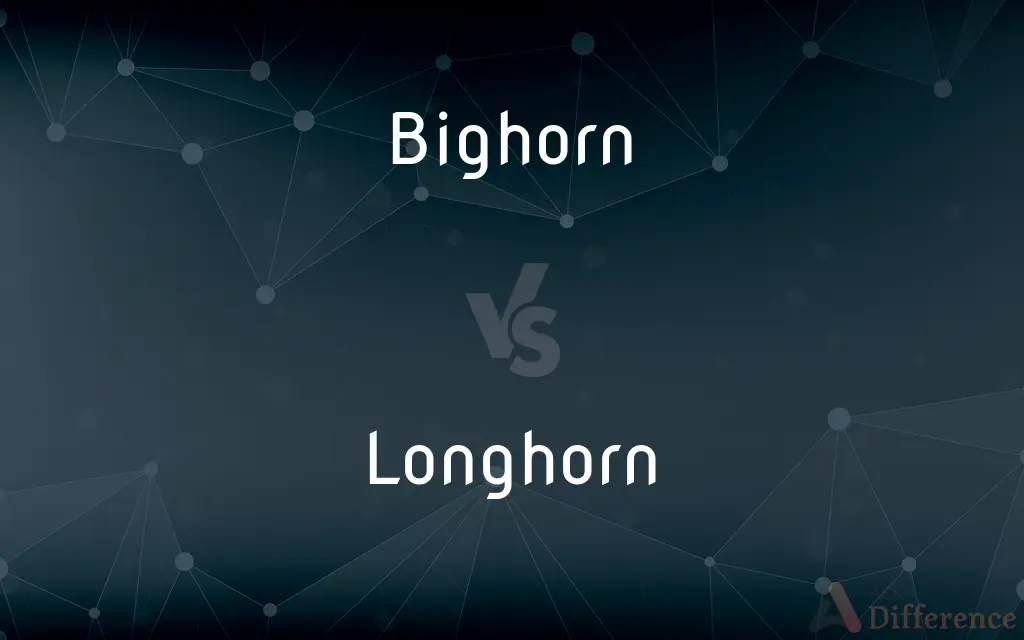Bighorn vs. Longhorn — What's the Difference?
By Fiza Rafique & Urooj Arif — Updated on March 28, 2024
Bighorn sheep are wild animals known for their large, curved horns; Longhorn refers to a cattle breed with distinctive lengthy horns.

Difference Between Bighorn and Longhorn
Table of Contents
ADVERTISEMENT
Key Differences
Bighorn sheep (Ovis canadensis) are native to North America, recognized for their impressive, large curved horns that can weigh over 30 pounds on males. These animals are well-adapted to mountainous terrains, using their agility to navigate steep, rocky slopes. Longhorn, on the other hand, refers to the Texas Longhorn cattle breed, famous for its exceptionally long horns, which can extend to over 7 feet from tip to tip. This breed has become a symbol of the American West, known for its hardiness and adaptability to various environments.
The bighorn sheep's habitat primarily consists of mountainous regions where they graze on grasses and plants. Their ability to climb and balance on steep cliffs helps protect them from predators. Conversely, Texas Longhorns are often found in pastures and plains, where they graze on a wide range of grasses. This adaptability in feeding habits contributed to the survival and proliferation of Longhorns in the rugged landscapes of the American West.
Bighorn sheep are social animals, forming herds that provide protection and mating opportunities. The males, known as rams, use their horns in combat for dominance and the right to mate. In contrast, Longhorn cattle were historically managed as domesticated animals by humans for their meat, milk, and hides. Their long horns served as a natural defense against predators and were also a factor in breeding selection by ranchers.
Conservation status and efforts highlight another key difference. Bighorn sheep populations have faced significant declines due to habitat loss, disease, and overhunting, leading to conservation measures aimed at their protection and habitat restoration. Texas Longhorns, once near extinction in the early 20th century due to crossbreeding and the expansion of the cattle industry, have seen their numbers recover thanks to preservation efforts by enthusiasts and ranchers who value their historical and cultural significance.
The cultural significance of both animals reflects their roles in human history. Bighorn sheep have been important in Native American cultures, featured in petroglyphs and as a source of food and materials. Texas Longhorns represent the cowboy culture of the American West, embodying traits of independence and resilience that have captivated the American imagination.
ADVERTISEMENT
Comparison Chart
Species
Ovis canadensis (sheep)
Cattle breed
Horn Characteristics
Large, curved horns on males
Extremely long, horizontally extended horns
Habitat
Mountainous regions
Plains and pastures
Social Structure
Form herds, males compete for dominance
Domesticated, historically managed in herds
Conservation
Subject to conservation efforts due to decline
Numbers recovered through preservation efforts
Cultural Significance
Important in Native American culture
Symbol of the American West and cowboy culture
Compare with Definitions
Bighorn
Primarily grazes on grasses and plants in mountainous areas.
Bighorn sheep are often seen grazing on the sparse vegetation of rocky slopes.
Longhorn
Symbolizes the heritage and culture of the American cowboy.
The Longhorn breed embodies the spirit of the American West, celebrated in rodeos and western art.
Bighorn
A species of sheep with large, curved horns, found in North America.
The bighorn sheep's agility helps it navigate the rugged mountain terrain.
Longhorn
Served as a work animal and source of meat, milk, and hides.
Texas Longhorns were an integral part of the early cattle industry in the United States.
Bighorn
Faces challenges such as habitat loss and disease.
Conservation efforts for bighorn sheep focus on protecting their habitat and preventing disease spread.
Longhorn
Once faced near extinction, now recovered through preservation efforts.
Ranchers and enthusiasts have worked to preserve the unique genetics of the Texas Longhorn.
Bighorn
Known for their impressive horn battles during mating seasons.
In the fall, male bighorn sheep engage in dramatic clashes with their horns.
Longhorn
A cattle breed known for its long, extended horns.
The Texas Longhorn is easily recognized by its distinctive lengthy horns.
Bighorn
Holds cultural significance for many Native American tribes.
Bighorn sheep are depicted in numerous petroglyphs, highlighting their importance in Native American cultures.
Longhorn
Adapted to thrive in various environments, especially in the American West.
Longhorn cattle are notable for their ability to forage on a wide range of grasses.
Bighorn
Certain North American species of sheep
Longhorn
Any of a breed of cattle with long horns and a brown and white coat, developed in England for meat and milk and now rare.
Bighorn
Especially, Ovis canadensis, having large, curving horns.
Longhorn
A Texas Longhorn.
Bighorn
The Rocky Mountain sheep (Ovis montana or Caprovis montana); called also bighorn sheep.
Longhorn
Any of various cow's milk cheeses, usually Colby or Cheddar, that are molded into a long cylinder and often cut into moon or half-moon shapes for sale.
Bighorn
A river that flows from central Wyoming to the Yellowstone River in southern Montana
Longhorn
A breed of beef cattle, having long horns, bred in Texas and other parts of southwest United States.
Bighorn
Wild sheep of mountainous regions of western North America having massive curled horns
Longhorn
A long-horned animal, as a cow, goat, or beetle. See Long-horned.
Longhorn
The Texas longhorn.
Longhorn
Long-horned beef cattle formerly common in southwestern United States
Common Curiosities
Where do bighorn sheep live?
Bighorn sheep live in North American mountain ranges, utilizing steep, rocky areas as their habitat.
How have Longhorn cattle adapted to their environment?
Longhorn cattle have adapted through hardiness and versatility in grazing, thriving in various environments.
What historical role did Longhorn cattle play in America?
Longhorn cattle were crucial to the cattle drives and the development of the cowboy culture in the American West.
What distinguishes the Texas Longhorn?
The Texas Longhorn is distinguished by its exceptionally long horns and historical significance in the American West.
Why are bighorn sheep populations declining?
Bighorn sheep populations are declining due to factors like habitat loss, disease, and historical overhunting.
Can bighorn sheep's horns be used to determine age?
Yes, the growth rings on bighorn sheep's horns can provide insights into their age.
How do bighorn sheep cope with predators?
Their agility and ability to navigate steep terrains help bighorn sheep escape predators.
Why were Longhorn cattle almost extinct?
Longhorn cattle were nearly extinct due to crossbreeding and changes in the cattle industry.
What are bighorn sheep known for?
Bighorn sheep are known for their large, curved horns and agility in mountainous terrains.
What are the conservation statuses of bighorn sheep and Texas Longhorns?
Bighorn sheep are subject to conservation efforts due to declining populations, while Texas Longhorns have recovered through preservation efforts.
How were Texas Longhorns saved from extinction?
Texas Longhorns were saved from extinction through dedicated preservation efforts and breeding programs.
What cultural impact do Texas Longhorns have?
Texas Longhorns symbolize the resilience and independence of the American West, impacting cultural expressions like art and rodeos.
Are there different subspecies of bighorn sheep?
Yes, there are several subspecies of bighorn sheep, including the Rocky Mountain bighorn sheep and the desert bighorn sheep, distinguished by their habitats and physical characteristics.
How do bighorn sheep and Longhorn cattle contribute to their ecosystems?
Bighorn sheep are key grazers in mountain ecosystems, while Longhorns help maintain grassland health through grazing.
What makes bighorn sheep's horns unique?
Their size, curvature, and the fact that they are used in dominance battles make bighorn sheep's horns unique.
Share Your Discovery

Previous Comparison
Autocrat vs. Dictator
Next Comparison
Liniment vs. OilAuthor Spotlight
Written by
Fiza RafiqueFiza Rafique is a skilled content writer at AskDifference.com, where she meticulously refines and enhances written pieces. Drawing from her vast editorial expertise, Fiza ensures clarity, accuracy, and precision in every article. Passionate about language, she continually seeks to elevate the quality of content for readers worldwide.
Co-written by
Urooj ArifUrooj is a skilled content writer at Ask Difference, known for her exceptional ability to simplify complex topics into engaging and informative content. With a passion for research and a flair for clear, concise writing, she consistently delivers articles that resonate with our diverse audience.















































